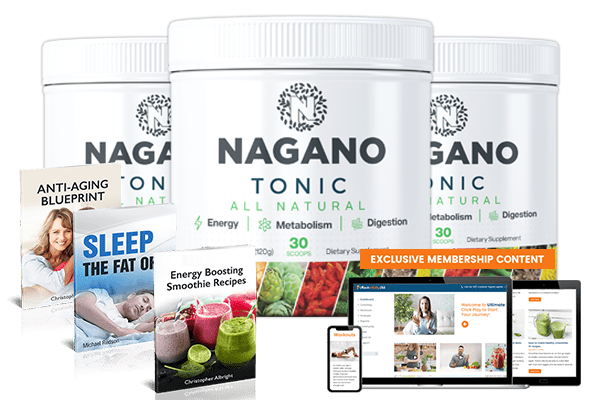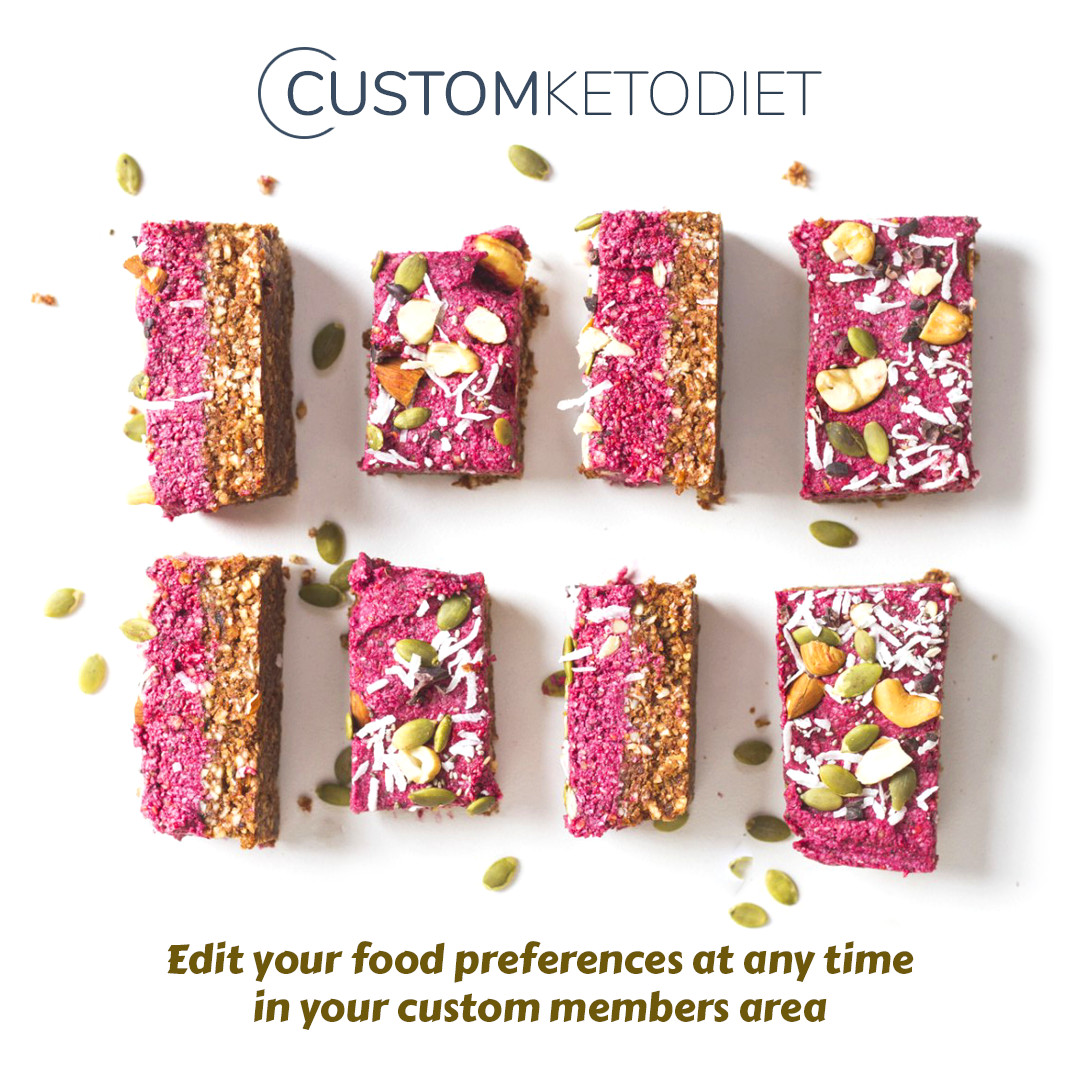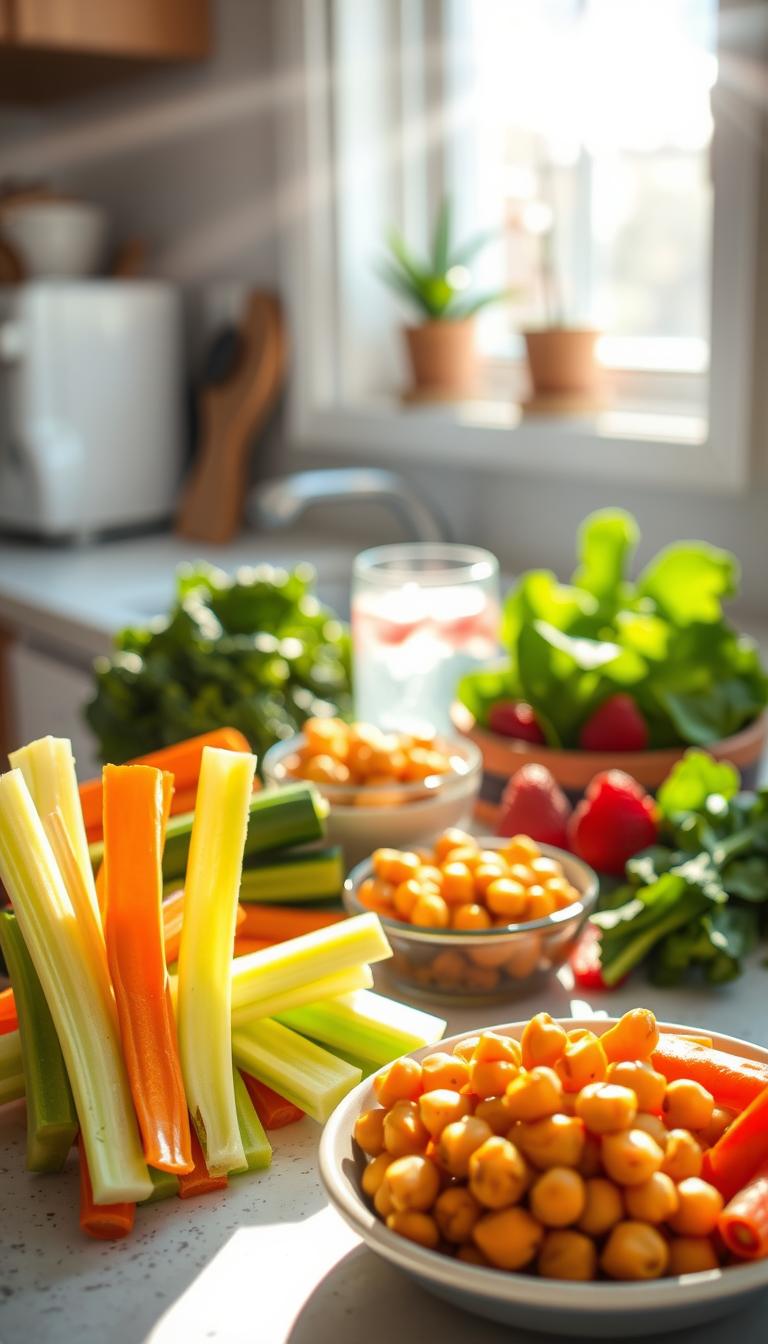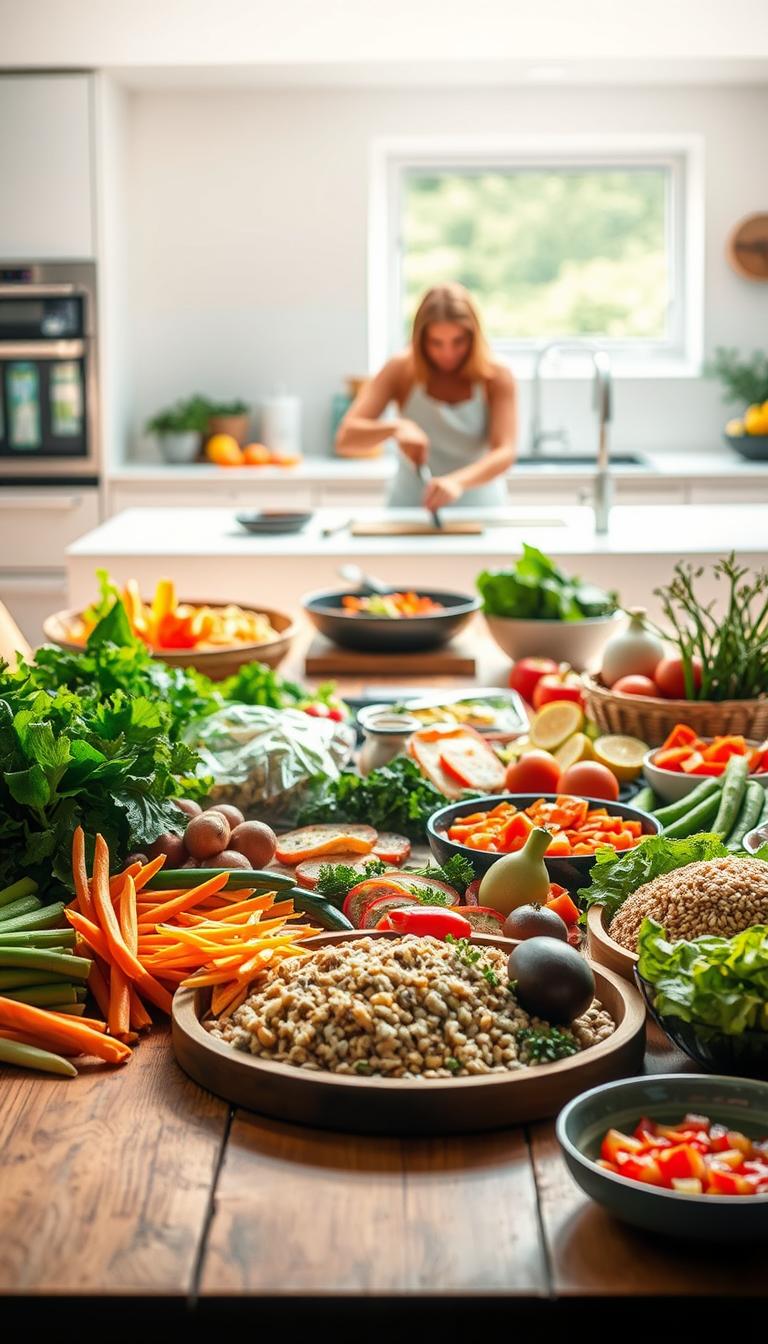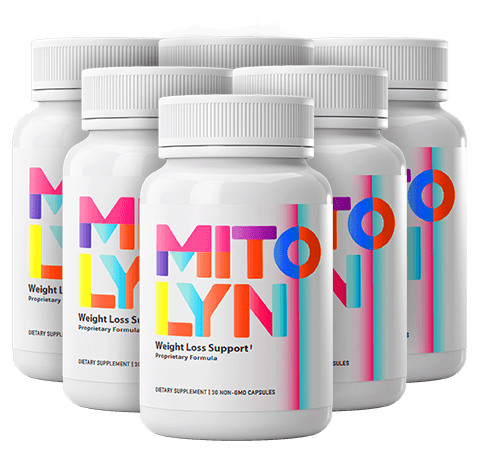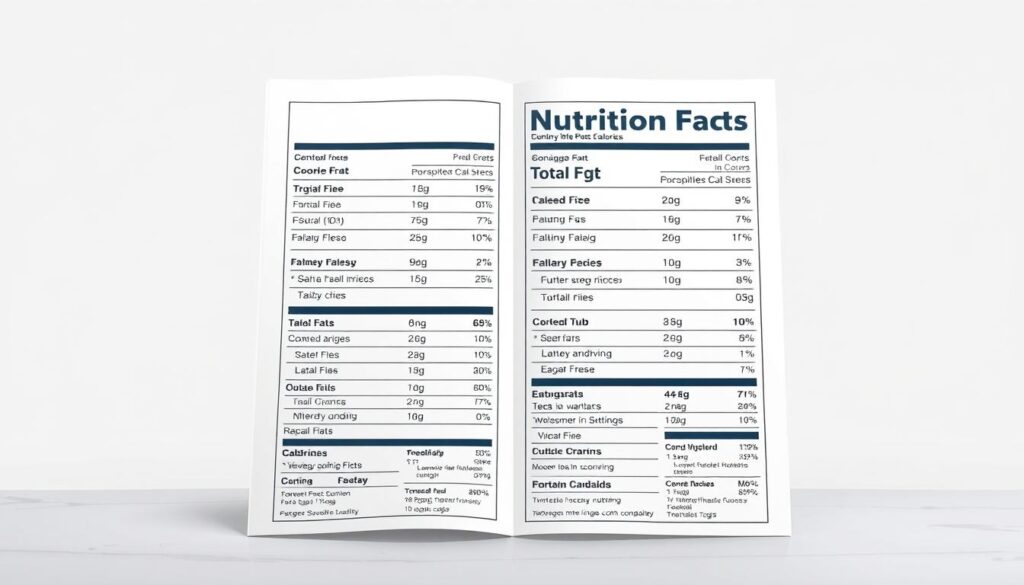
Eating well is more than just counting calories. It’s about giving your body what it needs. Imagine starting your day full of energy and staying sharp all day. Knowing your food choices help keep your heart, brain, and health strong.
With so many foods out there, it’s easy to get confused. But making small changes can make a big difference. Try swapping sugary snacks for nuts or choosing whole grains over white bread.
Every bite you take matters. Foods like sodas and candy might taste good but can harm your health. On the other hand, foods like veggies, eggs, and Mediterranean meals can boost your energy and help you live longer.
This guide will help you learn how to eat well. You’ll learn how to balance your meals, read food labels, and build healthy habits. These habits will benefit your health and the planet.
Key Takeaways
- Ultra-processed foods increase disease risks; nutrient-dense diets reduce them.
- Whole foods like eggs and veggies pack more vitamins and minerals per calorie.
- The Healthy Eating Plate recommends 50% vegetables and fruits per meal.
- Small changes, like swapping sugary drinks for water, add up over time.
- Food choices impact not just your health but also environmental sustainability.
Understanding Calories and Their Role in Nutrition
Calories are the energy units in food your body uses daily. Learning about calorie intake and healthy eating choices helps you fuel your body effectively. Let’s break it down:
What Exactly is a Calorie?
A calorie measures energy. Food labels use “Calories” (capitalized) to mean kilocalories. Here’s how they add up:
- Carbs/protein: 4 calories/gram
- Fat: 9 calories/gram
How Calories Affect Your Body
Your body burns calories for basic functions like breathing and physical activity. Excess calories stored as fat. For example:
| Food | 1 Serving | 4 Servings |
|---|---|---|
| Lasagna | 280 calories | 1,120 calories |
Empty calories from foods like donuts and soda lack nutrients, making them poor choices for healthy eating.
Why Calorie Awareness Matters for Health
Tracking your calorie intake helps balance energy use. Key tips:
- Men: Aim for ~3,000 kcal daily
- Women: Aim for ~2,400 kcal daily
- Choose nutrient-rich foods over empty calories
Remember: Your calorie intake impacts weight, energy, and disease risk. Small changes like swapping soda for water or adding veggies to meals boost nutrition without overeating.
The Complete Food Calories List You Need
Knowing
Understanding the food calories list helps you choose meals that align with your health goals. This guide breaks down calories in everyday foods. It shows how to balance low calorie foods with nutrient-rich options. Focus on foods packed with vitamins and fiber, even if they have moderate calories.
“Healthy foods are unprocessed and rich in nutrients like vitamins, minerals, and antioxidants.”
Choose avocados for heart-healthy fats or berries for antioxidants. Even higher-calorie fruits like bananas (81 kcal) provide quick energy.
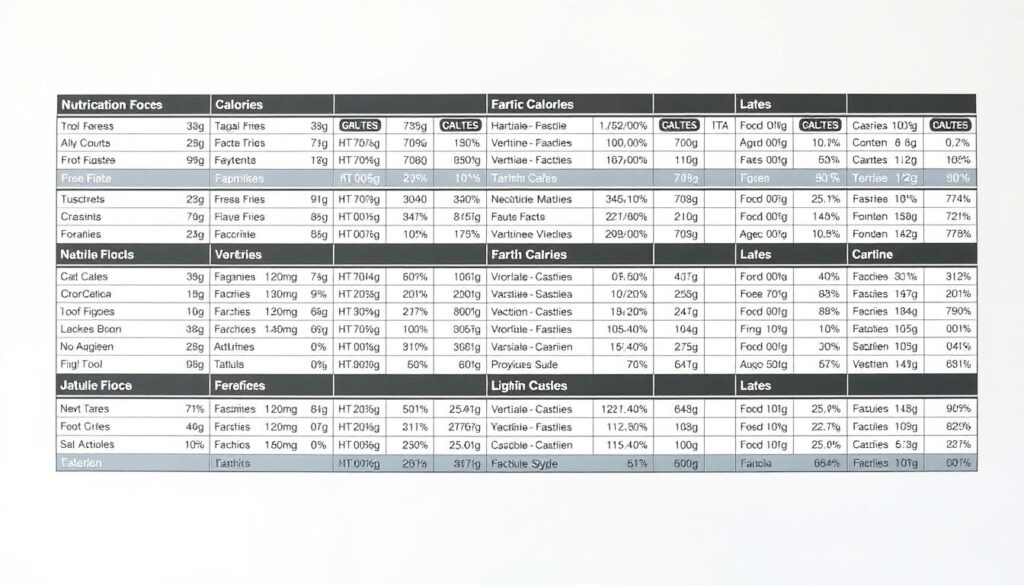
Leafy greens like spinach (25kcal/100g) and mushrooms (7kcal) are low calorie foods packed with nutrients. Celery (9kcal) adds crunch without calories. Aim for colorful veggies like broccoli (34kcal) to boost vitamins.
Whole wheat bread (217kcal/100g) has more fiber than white bread (275kcal). Opt for quinoa (111kcal) as a nutrient-dense grain option.
Use this food calories list to compare options. Prioritize nutrient density—like edamame (122kcal) for protein—over empty calories.
How to Read Nutrition Facts Labels Effectively
Learning to read nutrition facts labels is key for smart shopping. First, check the serving size to avoid eating too much. A small bag of trail mix might say 100 calories per serving. But, if it has 3 servings, the total calories are triple that.
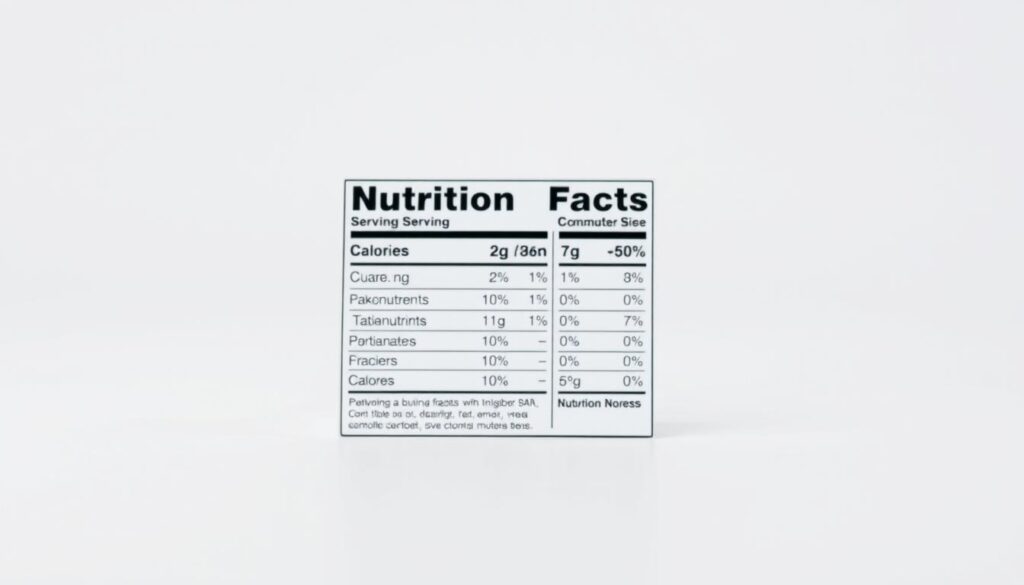
- Spot hidden sugars: Look at Total Sugars vs. Added Sugars. Plain milk has 12g Total Sugars. But strawberry yogurt might have 10g Added Sugars.
- Check % Daily Value (DV): Aim for 20% DV for fiber or vitamins.
- Read ingredient lists: Ingredients are listed by quantity. Look for whole foods like almonds or spinach near the top.
Labels now include Added Sugars thanks to 2016 updates. Use the calorie counter on labels to track your daily intake. For example, a “reduced fat” chip bag might still have high sodium or sugars—always check the full label. Keep an eye on allergens too: sesame is now required on labels as the 9th major allergen since 2023.
“FOP warning labels cut sugary drink purchases by 29% in Chile,” says a 2020 study, showing how clear labels guide better choices.
Remember: 2,300mg sodium/day is the general limit. Compare brands by scanning the same serving sizes. Your nutrition facts label is a roadmap to balanced eating—use it wisely!
Calorie Charts: Quick Reference for Everyday Foods
Knowing the calorie content of common foods helps simplify weight loss goals. Use this calorie chart as a daily guide. It helps balance choices without sacrificing taste.
“The FDA requires chain restaurants to display calorie counts, empowering diners to make informed decisions.”

Breakfast Foods Calorie Chart
- Banana: 105 calories
- Whole wheat bread slice: 70 calories
- Hard-boiled egg: 70 calories
- Plain Greek yogurt (1 cup): 130 calories
Lunch & Dinner Options
- Burger King Whopper (with cheese): 790 calories
- McDonald’s Quarter Pounder (with cheese): 520 calories
- Salmon (3 oz, cooked): 175 calories
- Quinoa (1 cup, cooked: 222 calories
Snacks & Desserts
- Dark chocolate (1 oz): 155 calories
- Almonds (1 oz): 160 calories
- Popeyes Chicken Sandwich: 700 calories
- Baja Burrito (chicken): 988 calories
Beverages
- Starbucks Caramel Frappuccino (Grande): 390 calories
- Whole milk (1 cup): 150 calories
- Panera Greek Salad: 400 calories
- Five Guys Burger (with cheese): 980 calories
These numbers show how small choices add up. Use this calorie chart with mindful portions. It helps meet your daily needs and weight loss goals. Adjust your favorites to fit your plan without feeling deprived.
Low Calorie Foods That Keep You Satisfied

Healthy eating doesn’t mean you have to miss out on taste or feel hungry. These low calorie foods offer big flavors and keep you full. They also help you keep your portions in check:
Nutrient-Dense Foods Under 100 Calories
- Oatmeal: ½ cup dry oats (154 calories) keeps you full longer than sugary cereals.
- Nonfat Greek yogurt: 1 cup packs 25g protein for under 150 calories.
- Blueberries: 1 cup has 86 calories and 3.6g fiber.
- Boiled eggs: 72 calories each, with 6g protein to curb hunger.
Volume Eating: More Food, Fewer Calories
| Fill-Powered Choices | High-Calorie Alternatives |
|---|---|
| 1 cup air-popped popcorn (31 calories) | 1 oz chips (154 calories) |
| 2 cups spinach salad (16 calories) | 1 oz cheese cubes (114 calories) |
Eat more of nutrient-rich veggies like broccoli (31 cal/cup) or zucchini (27 cal/cup) to feel full faster. Studies show eating soup or veggie-based meals can cut calorie intake by 20%.
Flavor-Packed Low-Calorie Alternatives
Swap high-calorie foods with these tasty options:
“Spice it up—turmeric, cayenne, and garlic boost flavor without calories.”
- Use roasted Brussels sprouts (70 cal/cup) instead of chips.
- Choose salsa or mustard over mayo (1 Tbsp = 90 cal).
- Marinate chicken breast (128 cal/serving) with lemon and herbs.
Pair foods like cottage cheese (163 cal/cup) with chia seeds (9.8g fiber/ounce) for a satisfying snack. These choices make healthy eating simple and delicious.
Understanding Your Daily Calorie Intake Needs
Your calorie intake needs are as unique as you are. Age, gender, and activity level all shape how many calories your body requires daily. Start by finding your Basal Metabolic Rate (BMR) using the Mifflin-St Jeor equation:
- Men: BMR = (10 × weight in kg) + (6.25 × height in cm) – (5 × age) + 5
- Women: BMR = (10 × weight in kg) + (6.25 × height in cm) – (5 × age) – 161

- Sedentary (little exercise): ×1.2
- Light activity (1-3x/week): ×1.375
- Moderate activity (3-5x/week): ×1.55
- Active (daily exercise): ×1.725
Use a calorie calculator to simplify these calculations. Adjust your intake based on goals: aim for a 500-calorie deficit daily for safe weight loss. Prioritize high-protein and high-fiber foods to stay full longer. Track hunger cues and adjust as your lifestyle changes. Remember, these numbers are starting points—not strict rules. Listen to your body while staying mindful of your calorie intake balance.
Smart Calorie Counting: Tools and Techniques
Tracking calories doesn’t have to be hard. Good calorie counter tools make it easy. They help with weight loss too. Using apps with journaling lets you see your eating habits without counting too much.
Top Calorie Counter Apps Worth Trying
- MyFitnessPal: Tracks over 11 million foods for free. Premium ($19.99/month) has more features. iOS rating: 4.6.
- Lose It!: Easy to use, it offers meal plans for $39.99/year. Works with Fitbit and more. Rated 5/5.
- Cronometer: Tracks 84 nutrients for free. Gold tier ($49.99/year) removes ads. Android rating: 4.5.
- FatSecret: Has 3 million foods in its database. Premium ($6.49/month) has more features. iOS rating: 4.8.
Creating a Simple Food Journal
Write down what you eat, how hungry you are, and how you feel. This shows patterns like eating when stressed. Use a notebook or app to find what triggers you, without focusing too much on calories.
Portion Control: Visual Guides to Serving Sizes

Use visual guides instead of measuring cups. A deck of cards = 3 oz chicken, a ping-pong ball = 1 tsp butter. These help you avoid eating too much. Use apps to help you eat right without counting.
Begin with these tools to learn more about your eating. Then, use them less as you get better at eating naturally. Let the data help you, not control you.
Balancing Macronutrients Within Your Calorie Goals

When making meals, aim to balance macro nutrients in your food calories list. Proteins, carbs, and fats each have their own roles. Here’s how to match them with your goals:
Proteins: The Building Blocks of Nutrition
Proteins help build muscles and keep you full. Try to get 10–35% of your daily calories from proteins. For a 2,000-calorie diet, that’s 150g of protein every day.
Choose lean meats, legumes, or Greek yogurt. High-protein snacks can also boost your metabolism and cut hunger.
Carbohydrates: Finding the Right Balance
Carbs give you energy. Pick fiber-rich foods like whole grains or quinoa. The USDA suggests getting 45–65% of your calories from carbs.
For a 2,000-calorie diet, that’s 260g of carbs. Stay away from refined sugars for steady energy.
Healthy Fats: Essential Calories for Optimal Health
- Healthy fats (nuts, avocados) should make up 20–35% of calories.
- In a 1,000-calorie meal, 33% fat = 37g from sources like olive oil.
- Limit saturated fats to under 10% of total calories to protect heart health.
“All diets work when calories are controlled,” said a 2020 review of 121 studies, showing no single macronutrient ratio guarantees success.
Use USDA guidelines as a starting point, not a strict rule. Adjust the ratios based on your activity level. Active people might need more carbs, while those trying to build muscle might want more protein.
Keep track of your progress and make changes as needed!
Common Calorie Myths Debunked
Sorting through calorie myths can feel overwhelming. Let’s cut through confusion with facts from nutrition experts. Here’s what science says about the most common myths:
- All calories are the same. Your body processes a 100-calorie cookie differently than a 100-calorie apple. While the calorie counts match, the apple provides fiber and vitamins, while the cookie offers empty calories. Check nutrition facts labels to see beyond just calorie totals.
- Low-calorie = healthy. Many “light” snacks replace fats with added sugars. For example, fat-free yogurt often has more sugar than full-fat versions. Always review the full nutrition facts panel.
- You must count every calorie. Obsessively tracking every bite with a calorie calculator can increase stress. Focus on balanced meals instead of pixel-perfect counts.
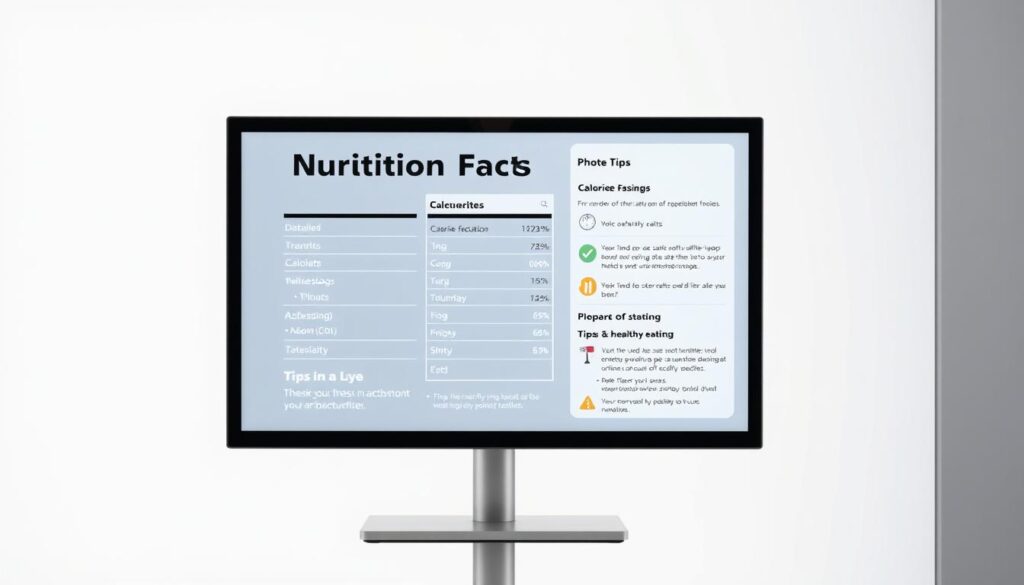
“Cheat days” aren’t acceptable. If your diet requires “cheat days,” it’s time to rethink your approach. Healthy eating should feel sustainable, not like a prison sentence.
Myth #4: Natural means low-calorie.
A “natural” cookie still has sugar and calories. Always check the nutrition facts—even “natural” snacks can add empty calories quickly.
Myth #5: Eating late causes weight gain.
Calories matter more than timing. What you eat (not when) drives results. Use tools like the USDA’s calorie calculator to focus on daily totals.
Remember: Prioritize whole foods like nuts and avocados. These nutrient-rich options satisfy longer than processed snacks. Tools like NutriSnap simplify tracking macronutrients without stress. Progress—not perfection—is the goal!
Conclusion: Making Food Calories Work for Your Health Journey
Understanding food calories is not about strict rules. It’s a tool to fuel your body’s needs while enjoying meals. Foods like vegetables, whole grains, and lean proteins are key for healthy eating.
Research shows these foods help with weight loss and long-term health. A study found diets rich in these foods led to less weight gain. On the other hand, processed snacks and sugary drinks did the opposite.
Use calorie tracking apps or portion guides to stay mindful. But focus on consistency, not perfection. The 2007 JAMA study showed even small habits, like regular logging, improve outcomes.
Prioritize foods that keep you satisfied, like high-fiber veggies or protein-packed snacks. Pair this with hydration and mindful eating to avoid restrictive diets. Progress comes from gradual changes, like swapping soda for water or adding more veggies to meals.
Every choice moves you closer to your goals without sacrificing joy.
Tools like calorie apps or food journals are guides, not strict rules. The 2010 study on protein and glycemic index showed even small adjustments—like choosing high-protein options—help maintain results. Celebrate balanced meals that nourish your body and taste buds.
Over time, these choices build habits that stick. Remember, healthy eating isn’t a temporary fix but a lifestyle that values both nutrition and enjoyment. Let calorie awareness guide mindful decisions, not control them. With patience and consistency, small steps lead to lasting change.




